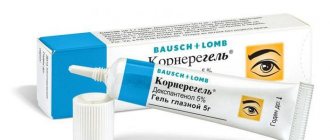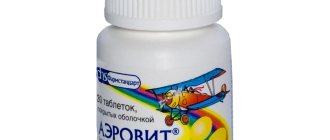Synonyms: Memoria
The homeopathic remedy Memoria has a beneficial effect on memory and blood circulation in the brain. This drug increases brain metabolism and also has a nosotropic effect, increases vascular elasticity, and enriches blood, cells and tissues with oxygen. It is very effective in cases of strong mental stress, increases concentration and has a positive effect on learning ability. Memoria has a good effect on the recovery of the body after traumatic brain injury and concussion, especially if the patient is in a state of prostration. The homeopathic remedy slows down age-related changes and has a positive effect on the emotional state of the patient.
Pharmacodynamics and pharmacokinetics
Pharmacodynamics
Memoria has a complex effect on brain metabolism . The drug improves hemodynamics and oxygen supply to all brain tissues, relieves vascular spasms, normalizes the metabolic process and the energy potential of nervous system cells, improves blood circulation in the vessels of the eyes and brain.
Affects the process of platelet aggregation, improves membrane-stabilizing properties , which enhances the strength and elasticity of blood vessels. As a result, the symptoms of cerebral circulation disorders that develop against the background of trauma to brain structures are quickly relieved - headaches, tinnitus, head noise, frequent dizziness, irritability, anxiety, emotional lability, asthenia, depressive symptoms .
The drug improves memory , concentration during mental work, associative processes, increases ability to work and the speed of psychomotor reactions. Memoria increases learning ability, restores clarity of consciousness, and slows down the development of age-related changes in brain structures.
Pharmacokinetics
Data not provided.
Pharmacological action of Memoria
Memoria is a complex drug that has a nootropic effect, manifested in the form of improved memory and mental activity, and brain resistance to aggressive external influences.
In addition, the drug has a vasoregulatory antihypoxic effect, improves blood circulation, stimulates the nutrition of cells and tissues with oxygen, and saturates the blood with oxygen.
Memoria's ingredients have a beneficial effect on blood vessels: they reduce the permeability of the walls and reduce susceptibility to vasoconstrictor nutrients. In addition, the components of the drug normalize the blood formula, prevent the formation of blood clots, and improve blood flow in the vessels of the eyes.
Thanks to Memoria, information is remembered better, psychomotor reactions and mental activity improve, learning ability increases, age-related changes in the brain occur more slowly, and clarity of consciousness returns.
There are positive reviews about Memoria from patients suffering from cerebrovascular accidents. Under the influence of the drug, tinnitus, headaches disappear, and absent-mindedness is eliminated. In addition, Memoria successfully combats emotional lability and increased fatigue.
The instructions for Memoria indicate the composition of the drug. It includes: Arnica, Hypericum, Ginkgo, Conium, Ginseng or Ginseng.
Arnica is used to treat contusions, apoplexy, hypertension, painful shock, nosebleeds, fractures, injuries after operations, atherosclerosis, burns and frostbite, boils, hemorrhoids, thrombophlebitis, dizziness when walking, bedsores, weakness, nervous exhaustion, insomnia, hemorrhages in the sclera and retina, paresthesia, and also to relieve numbness in the hands.
Hypericum, one of the components of Memoria, is used to treat injuries to the brain and spinal cord, injuries that provoked a violation of the integrity of the nerves, cachexia, neuralgia, neuritis with accompanying stabbing and shooting pains, epilepsy and neuritis (traumatic), writer's cramp. Hypericum is effective in relieving phantom and headaches, pain in the hip joint, paresthesia, for treating deteriorating memory, eye fatigue, hair loss, nosebleeds, and eliminating eye strain.
Ginkgo, a substance included in Memoria, is used to eliminate cerebral circulation disorders, hearing and memory impairment, absent-mindedness, migraines, vascular atherosclerosis, tinnitus, tremors, chronic fatigue, and problems with impaired motor coordination. Ginko is also used to treat sudden mood swings, apathy, depression and weather dependence.
The next component of Memoria is Conium. Its effectiveness has been proven for sclerosis, paralysis, convulsions, paresis, paresthesia, diplopia, insomnia, presbyopia, cataracts, severe irritability, myopia, fears, severe lacrimation, sudden mood swings, senile farsightedness and photophobia. In addition, Conium is used to eliminate sensations of compression in the temples, dizziness that occurs in a horizontal position, dull headaches that occur mainly in the morning, hot flashes to the back of the head.
Ginseng (Ginseng) is effective for rheumatism, lumbago, headaches, dizziness, sciatica, disturbances in sleep and vision rhythms, and nervous exhaustion.
Indications for use
Memoria is prescribed for the treatment of disorders of brain activity and cerebral circulation, therapy of cerebral atherosclerosis , injuries with damage to brain structures.
The drug is indicated for memory loss , impaired concentration, high intellectual stress, as well as for migraines , dizziness, and headaches.
Composition per film-coated tablet:
Active substance:
Domperidone - 10.0 mg
Excipients:
- lactose monohydrate - 48.44 mg,
- microcrystalline cellulose - 10.0 mg,
- povidone (low molecular weight polyvinylpyrrolidone) - 10.0 mg,
- glycerol (glycerin) - 0.56 mg,
- magnesium stearate - 1.0 mg,
- corn starch - to obtain a tablet without a shell weighing 100.0 mg
Excipients (coat):
Hypromellose - 1.74 mg, macrogol 6000-0.26 mg to obtain a film-coated tablet weighing 102.0 mg.
Instructions for Memoria (Method and dosage)
The drug is prescribed to adults and adolescents, 10 drops orally 3 times a day. Memoria drops are taken half an hour before or 1 hour after meals in their natural form, or the drops are diluted in a tablespoon of water. The duration of treatment is 60-90 days. If necessary, a second course of treatment is possible according to indications.
If quick relief of symptoms is required, the drug can be taken 8 drops every 0.5-1 hour, not exceeding eight times a day, and after relief of symptoms, switch to taking it three times a day.
The instructions for use of Memoria recommend holding the drug in your mouth for some time before swallowing the drops, which increases the effectiveness of its action.
Composition of the drug Memoria. Release form
Memoria drops are dark yellow or light yellow in color. The drug does not have a distinct odor and is available in dark glass bottles with a dispenser. Bottles of 20ml, 50ml or 100ml are packed in cardboard boxes with instructions for use.
Memoria tablets are white, sometimes interspersed with gray. Flat, small in size. Blisters are packed in cardboard boxes with instructions.
The composition of the drug Memoria per 100 ml includes the following components:
- St. John's wort (Hypericum) D1 15 ml;
- Ginkgo biloba (Ginkgo) D6 10 ml;
- Spotted hemlock (Conium) D6 10 ml;
- Ginseng D6;
- Mountain arnica (Arnica) D12;
The excipients are:
- Ethanol 43%;
- Purified water.
During storage of the drug, the liquid may become cloudy and a small sediment may appear. The taste and smell of the drops may change. This does not affect the quality of the homeopathic remedy and it can continue to be used.
The drug should be stored at room temperature. The shelf life of Memoria is 5 years.
Interaction
When using the drug, it is necessary to take into account that St. John's wort, which is part of it, can change the effectiveness of the therapeutic effects of a number of drugs: it enhances the antidepressant effect of monoamine oxidase inhibitors .
When used together with Fluoxetine , sertraline , Paroxetine , Citalopram or fluvoxamine :
- complicates hemolytic reactions;
- may enhance the photosensitizing effect of sulfonamides , tetracyclines , Piroxicam , thiazide diuretics ;
- reduces the hypotensive effect of Reserpine ;
- reduces the blood concentration of Digoxin , Cyclosporine and the effectiveness of treatment with indinavir ;
- reduces the effectiveness of anticoagulants ( Phenprokumon , Warfarin ).
Analogues of the drug Memoria
There are no complete analogues of this drug. But there are medicines that are similar in composition and indications for use. You should not replace Memoria with similar products yourself, otherwise the effect may be completely different from what is expected.
Analogues of Memoria include the following drugs:
- Bilobil;
- Neuroximet;
- Tanakan;
- Alcheba;
- Memoplant;
- And others.
Please note that this article is for informational purposes only. You should not prescribe the drug to yourself or your loved ones; any use of the drug, its dosage or replacement with analogues should be discussed with your doctor. Do not self-medicate.
Reviews about Memoria
Reviews about Memoria are favorable. Students leave especially good reviews about the drug, many of whom take a course of treatment once every six months before or during sessions. There is an improvement in memory and concentration, and the material being studied is better remembered.
A good effect is noted by patients suffering from cerebral vascular spasms . A preventive course of treatment in spring and autumn, when there are strong changes in atmospheric pressure, has a good effect on health. After a course of treatment, headaches, tinnitus, and drowsiness disappear. Many people after 40 years of age use it as a preventive measure.
How to make money with Memoria
Welcome to the Memoria website, where any user with imagination can earn extra money.
The goal of our project is to accelerate the memorization of foreign words. You can participate in creating associations for foreign words, and you will receive a reward for creative stories.
Instructions for authorsInstructions for illustrators
How it works.
A consonant Russian word (one or several) is selected for a foreign word and these words are linked together by a common plot.
For example:
Glass (English) – glass. In this case, the consonant word “eye” is ideal. The author’s task is to connect the words “glass” and “eye” with an interesting, unusual plot. The more unusual the plot, the more emotions it evokes, the more valuable the association. The more banal the plot, the less memorable the association.
Examples of plots with this pair of words:
- “You rub your eyes as if there was a speck in there. As a result, you take the glass out of your eye.”
- “You are looking at a man who, instead of glasses, has two glasses, from under which his eyes can be seen.”
- “You take a glass, look into it, and it’s filled to the top with eyeballs.”
- etc.
Of the stories described above, in our opinion, the last one is the most emotional and memorable. Fear and disgust are additional emotions that (in this case) contribute to memory.
To get started, you just need to select any word from the list provided and send us the story. If your story is accepted by our team, you receive a monetary reward (accounting for bonuses and payments in your personal account).
If you do not understand transcription (symbols of the correct pronunciation of a word), you can simply listen to how this word sounds. For any words, we accept up to 3 stories and choose the best one. Words are ranked by difficulty (simple, short words with a specific meaning are easier to come up with associations than long, abstract words). Accordingly, the pay is higher for stories with longer words.
Instructions for authors
Go to the “words” section, you will see lists of words available for submitting a story. Describe the story and click submit. See the history in your office. If the plot is successful, you will be awarded a bonus. The main reasons for refusal to accept a plot:
- The foreign word is so consonant with the Russian one, there is no need to take such words (example: pilot - pilot)
- A banal plot, gray and unmemorable (example: pleased - pleased. The proposed plot: “A satisfied botanist found a leaf.” The consonant words leaf and pleased were chosen well. But the plot is uninteresting. It would be much more interesting if he didn’t just find it, eat it, or whatever - then stuck it in. More unusual interactions between plot elements.
- Cumbersome plot with many minor elements. Example: impress - to make an impression, consonant with the word press. The author proposed the following plot: “THE BLACKSMITH MADE AN IMPRESSION ON THE DISSATISFIED CLIENTS WHEN HE TOOK OUT OF HIS POCKET A SMALL METAL PRESS HE BROUGHT, SPLATCHED THEIR COINS IN IT, AND SMILED EVILLY, BEGAN FORGING A KNIFE.” The plot contains unnecessary details such as “smiling evilly.” Ideally, the plot should have 2 elements “linked” by an unusual interaction, and that’s it.
- We do not accept mnemonic phrases, such as “Ann is a bicycle postman, she will instantly deliver any envelope.” (for remembering the word envelope. Or: “Everyone heard my loud call.” (for remembering each). These are not plots for pictures. Such phrases help, but this is not our thing. Such phrases need to be crammed a little. Our goal is to create content for memorization based on visual perception. We will take mnemonic phrases on a residual basis, information about this will appear next to the corresponding word.
- We do not accept stories with grammatical errors, learn Russian)
- Well, our content is 6+, keep this in mind when creating stories.
We are ready to discuss any questions in the Chat.
Instructions for illustrators
Select any plot from the list and draw an illustration based on this plot. If the illustration suits us, you will be awarded a reward.
Examples:
duty
Plot:
The sentry near the monument blows it up like an inflatable ring. These are his responsibilities.
string
Plot:
A boxer in the RING breaks the strings of his guitar.
scream
Plot:
The actor SCREAMED loudly when the MAKE-UP was applied to him.
genius
Plot:
The GENIE FROM the lamp called upon the genius to free him.
except
Plot:
A French EXPERT rated all the dishes in Russia, except okroshka.
fungus
Plot:
The man ignored hand washing and mold grew on his phalanges of his fingers.
forge
Plot:
That grandfather? strange blacksmith. He recently forged a WINDOW.
revelation
Plot:
Lenin opened the door of REVOLUTION for the people.
Good luck!
Memoria price, where to buy
Memoria drops can be purchased in pharmacies in Moscow and other Russian cities. The price of the drug depends on the volume of the bottle. The cost of the drug in a 50 ml bottle ranges from 337 to 420 rubles, and in 20 ml bottles - from 215 rubles. up to 259 rubles.
- Online pharmacies in UkraineUkraine
Pharmacy24
- Memoria 50 ml drops Richard Bittner AG, Austria
194 UAH order - Memoria 20 ml drops Richard Bittner AG, Austria
104 UAH order
Contraindications
Memoria drops are not recommended for children under 12 years of age, but there are cases when a doctor may prescribe a homeopathic remedy. You must strictly adhere to the dosage chosen by the doctor.
If the patient has any liver disease, then it is better to avoid this drug.
Pregnancy and lactation are also contraindications to the use of Memoria, however, in individual cases it can be taken as prescribed by a doctor.
Individual intolerance to certain components of the drug can cause adverse allergic reactions in the body.
Description:
Round, biconvex tablets, white film-coated, with a white core in cross-section.
Pharmacotherapeutic group:
antiemetic dopamine receptor blocker central.
ATX Code:
A03FA03
pharmachologic effect
Pharmacodynamics
Blocks peripheral and central (in the trigger zone of the brain) dopamine receptors, eliminates the inhibitory effect of dopamine on the motor function of the gastrointestinal tract and increases the evacuation and motor activity of the stomach. Has an antiemetic effect, soothes hiccups and eliminates nausea. Increases the concentration of prolactin in the blood serum.
Pharmacokinetics
Absorption after oral administration on an empty stomach is rapid (taking after meals, reduced acidity of gastric juice slows down and reduces absorption). Time to reach maximum concentration (TCmax) - 1 hour. Bioavailability - 15% (first pass effect through the liver). Communication with plasma proteins - 90%. Penetrates various tissues and does not pass well through the blood-brain barrier. Metabolized in the liver and in the intestinal wall (by hydroxylation and N-dealkylation). 66% is excreted through the intestines, 33% by the kidneys, incl. unchanged - 10% and 1%, respectively. The half-life is 7-9 hours, and in cases of severe chronic renal failure it is extended.
Interaction with other drugs
Cimetidine and sodium bicarbonate reduce the bioavailability of domperidone. Anticholinergic drugs neutralize the effect of domperidone.
Increase the concentration of domperidone in plasma: azole antifungal drugs, macrolide antibiotics, HIV protease inhibitors, nefazodone (antidepressant). Compatible with the use of antipsychotic drugs (neuroleptics), dopaminergic receptor agonists (bromocriptine, levodopa).
Concomitant use with paracetamol and digoxin had no effect on the concentration of these drugs in the blood.
Information about the possible effect of the drug on the ability to drive vehicles and machinery
There is no separate data.



